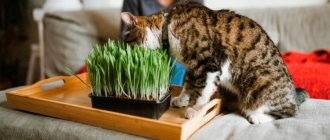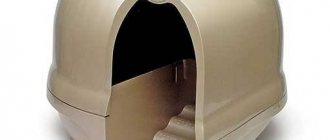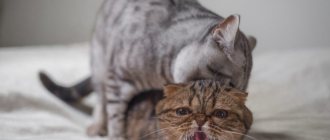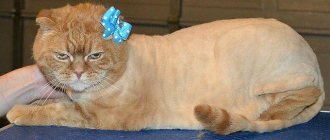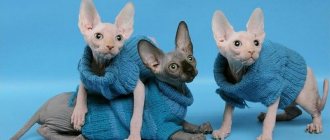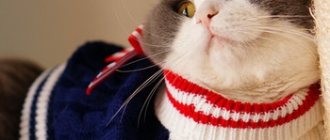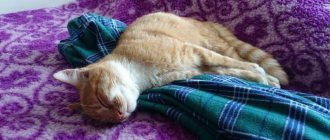Clothes for cats - necessity or whim?
Even the ancient Egyptians used clothing for cats. It was in Egypt that cats were especially revered and valued. They were given precious stones, delicious food and expensive clothes as gifts. Despite the fact that the deification of cats remains in the distant past, some features of their maintenance have survived to this day.
It is necessary to dress pets not only for the sake of beauty or the whim of the owner, but also to protect the body from hypothermia, overheating, precipitation and drafts. Of course, not all four-legged friends will need items of clothing: some breeds have a thick coat and thick undercoat, so they do not need insulation. The same cannot be said about Sphynxes and smooth-haired cats; they need protection from the harsh Russian winters.
Also included in the vulnerable category are kittens, old pets and animals that have undergone surgical operations with extensive clipping of areas of fur.
In any case, a blanket is put on your four-legged friend after surgery to prevent the animal from licking or scratching the wound. In this case, the medical bandage also protects the cat from cold and drafts.
Sphinxes are dressed not only in winter, but also in summer. To protect pets from the scorching sun, cotton T-shirts are used. If this is not done, the skin of Sphynxes and Levkoys will become dry and covered with spots.
Clothing saves cats that are accustomed to walking outside not only from precipitation, but also from fur contamination and parasites. In the latter case, there is no 100% guarantee of protection, but protective overalls significantly reduce the risk of disease. To protect a cat from accidental relationships with other animals, you can also put a protective suit on it, and then the owner will not have to solve the problem with kittens.
Some owners dress up their pets in beautiful holiday outfits, which in everyday life are not entirely comfortable for constant wear. As a rule, this is done for participation in exhibitions and photo shoots.
Why does a cat need clothes?
Street and many purebred cats have thick fur with an undercoat that keeps them warm even during winter walks. However, there are breeds with a modest coat or no coat at all. As a rule, these are elite hybrid cats whose ancestors lived in Southeast Asia or on the African continent.
Their natural habitats are characterized by hot weather and the absence of winter. In such a climate, individuals with short hair with virtually no undercoat survived better. In addition to natural selection, these cats were worked on by breeders who, through crossing, developed hairless breeds such as the Sphynx.
These exotic animals are also in demand in Russia. Once in our cool climate, hairless cats feel cold and can catch a cold, so owners should take care of warm clothes for them. A jumpsuit or other type of clothing will keep your cat healthy and help her feel comfortable in any weather.
Materials and requirements
The main materials in the manufacture of clothing for cats are:
- cotton and linen fabrics, calico - ideal for sewing summer clothes. Thanks to excellent thermoregulation, the animal feels good, even on the hottest summer day. The only negative is that after washing the clothes shrink and become very wrinkled;
- synthetic materials are ideal for sewing elegant holiday costumes. This type of material is not used for everyday wear due to low air permeability;
- wool, knitwear - for winter clothing options. For example, mohair has high breathability and provides excellent warmth and does not cause allergies in pets.
The material of things intended for walking is combined - for example, water-repellent fabrics are combined with padding polyester filling. These fabrics are easy to wash, dry quickly and practically do not wrinkle. The top layer of clothing (especially for spring and autumn) is made of bolognese fabric or raincoat. It perfectly repels moisture and protects the animal's fur from dirt.
For everyday clothing, it is necessary to select lightweight fabrics that will not hinder the animal’s movements. If the material of the costume clings or causes any discomfort, the pet may be injured during active games.
Home clothes for daily use must meet the following requirements:
- easy to wash;
- fabrics must be durable and light. During wearing, cats often cling to clothes with their claws, and in order not to tear the outfit, the material must be strong enough;
- a minimum of accessories (i.e., exclude the presence of an excessive number of rivets, buttons, zippers, fasteners and ruffles);
- seams and fasteners must be hidden. Buttons should not be sewn on at all; the animal can tear them off and swallow them.
How to choose a cat costume in a store
Clothes for four-legged pets can be bought in the store. The retail chain offers a wide variety of cat apparel. The most common among them:
- One-piece overalls with a cutout for the head, paws, and tail. This walking suit retains heat better than others.
- An autumn-winter version of jackets that cover the main part of the body.
- Sweaters, vests. You can knit such things yourself using patterns, of which there are many on the Internet.
- Shirts, pajamas, T-shirts. They are worn in spring and summer, when dangerous ticks are especially active.
- Accessories, including: blankets, hats, socks.
The cost of clothing for tailed animals ranges from 140 to 1500 rubles. Costumes for exhibitions and holidays can cost more than 2-3 thousand rubles.
Specialized stores have a large assortment of cat clothing and accessories.
In stores you can buy sets of clothes of different sizes, including for kittens.
Material selection
The material is of considerable importance when choosing an outfit for a cat. Autumn overalls can be made of smooth satin, thin fleece and have a lining. Sweaters are made from wool (usually rabbit, but preferably angora). The material for all kinds of blankets and hats can be linen, chintz, and cotton.
Clothing made from natural wool warms a cat well, but it should not be itchy, so choose outfits made from rabbit or angora down.
You need to choose things with a small number of seams, there should not be many buttons or zippers. Many accessories can rub the animal’s skin, cling to the fur and cause inconvenience, especially for active cats during movements.
How to choose the size
Knowing the right size will make the task much easier. Large and small clothes are equally inconvenient for your pet, and he may simply refuse to wear them.
Are the clothes comfortable?
Any outfit should not cause inconvenience to its owner when worn. To check this, you need to run the wrong side of the product over your cheek. If the clothing does not cause any irritation, then it will suit the cat.
Cat outfits
Manufacturers of pet products, in addition to food, vitamins and other paraphernalia, also offer a wide selection of outfits. For example:
- Overalls, jackets and raincoats are protective clothing for your four-legged friend from cold, rainy and dirty weather.
- T-shirt, shirt - suitable for use at home or in warmer months. This type of clothing protects your pet from excessive overheating and harmful parasites (ticks, mosquitoes and fleas);
- A blanket and vest are an indispensable outfit for walks or during the postoperative period;
- Bathrobe - put on the pet after a bath and water procedures;
- Protective body – prevents accidental mating of a cat with a male;
- Original suits and dresses – for exhibitions and photo sessions;
- Hats and boots - used either in cold, dirty weather, or for exhibitions and photo shoots.
Cute vest for a cat
To create this cat clothing pattern, you need to know the cat's neck circumference, back length, bottom circumference, and the length between the legs. If you want to use clasps, leave a small allowance for them.
Step 1. Mark the neck circumference measurement on a white sheet, but not with a straight line, but with a slightly rounded line. Exactly in the middle, draw a vertical line equal to the length along the back. The bottom part of the picture is the bottom of the product, its value is equal to the circumference of the cat’s lower body. Divide the “distance between the paws” parameter by 2, the resulting figure is the line to the beginning of the holes for the paws (on both sides of the vertical line). The dimensions of the vertical length of the vest depend on how long you want to give the product.
Step 2. Transfer the data to the selected fabric by attaching the pattern to it. Cut the resulting blank with scissors, then sew the product by connecting two opposite sides AB and CD. Cut out the piece, leaving a little space for the seam, then cut out the armhole for the paws, then hem or border the edges of the piece.
How to determine the size of a product?
Each pet has its own structural features and body size. When choosing clothes, you should focus not only on the physical parameters of the animal; many nuances depend on the breed and age of the pet.
How to determine the correct size? Take a tape measure and measure your furry friend. Required measurements:
- neck circumference - measure at the widest point;
- chest circumference (measure under the front legs);
- length along the back from the withers to the base of the tail;
- head circumference (for hats).
Cat clothing sizes are classified depending on the back length:
- 30 cm (XXS);
- 33 cm (XS);
- 35 cm (S);
- 37 cm (M);
- 40 cm (L);
- 45 cm (XL);
The clothes purchased should be durable, comfortable and practical. After washing, high-quality items do not shrink, stretch or wrinkle too much. When choosing clothes for your pet, consider the time of year: in winter, warm clothes are the best option, and for the autumn-spring period, microfiber and raincoat fabric are suitable. In summer, it is best to buy breathable outfits.
How to sew a cat costume yourself
When it is expensive to dress pets in stores, owners of mustachioed fashionistas and dandies often have the desire to sew or knit clothes for their pets themselves. It's easy to do by learning some tips on how to turn into a fashion designer for your four-legged companion. An ordinary outfit made with your own hands will bring pleasure to both the owner and her cat. You only need:
- choose the right material for clothing;
- carefully make patterns;
- take measurements from the cat.
And in order for your pet to like the sewn clothes, you need to try to see the world around you through the eyes of your pet.
Choosing fabric for sewing
If the right choice of fabric is made, half of the success in sewing clothes for your cat yourself is guaranteed. For this to happen, you need to answer yourself the following questions:
- what breed is the cat?
- what age is this animal;
- purpose of using clothing (for exhibitions, protection from the cold);
- What season will the outfit be made for?
When choosing a fabric, you should take into account indicators of its quality and wear resistance, namely:
- compound;
- Is the fabric capable of fading and shrinking when washed?
- is it easy to work with;
- how much the material wrinkles;
- Can it fade in the sun?
Rolls of fabrics have labels indicating the composition of the material, which will help you choose the right type.
Types of materials
All fabrics have their own advantages and disadvantages:
- Cotton and viscose fabrics consist of natural hypoallergenic fibers. They are soft, quickly absorb moisture, do not electrify, and are easy to wash. The disadvantages include the fact that they wrinkle easily, become deformed when worn, and take a long time to dry.
- Linen fabric is hygroscopic and hygienic. It is hypoallergenic, has good thermal conductivity, and resists UV radiation. At the same time, after washing, linen shrinks a lot, crumbles, and becomes deformed when worn.
- Wool is a natural material, does not wrinkle, and retains heat well. It is resistant to stains. Its disadvantage is the pellets that form on the fabric, and it also stretches during use.
- Synthetic is a durable fabric, washes well, retains the appearance and shape of the product for a long time. However, fabrics made from artificial raw materials quickly absorb and store various odors for a long time and become highly electrified. They can cause an allergic reaction in the animal.
- Blended fabric can have all the benefits of its constituent fibers.
When purchasing suitable material for sewing clothes for a pet, you should choose high-quality fabric that has a high content of natural raw materials.
Which fabric should you not choose?
You should not buy inelastic material, as it will make it difficult for the cat to move. In addition, you need to refuse to purchase fabric if it:
- has an unpleasant odor;
- washes poorly;
- wrinkles easily;
- rustles;
- takes a long time to dry;
- capable of deformation;
- may crumble on cuts;
- openwork, relief structure.
Material for walking clothing depending on the season
The material is chosen depending on the season in which it is planned to walk the animal in clothes made from it:
- for spring it is better to prefer impregnated raincoat fabric, waterproof taffeta;
- in summer, mixed fabrics containing mainly cotton and viscose are suitable;
- for the autumn season - denim, microfiber, impregnated raincoat material;
- in winter - a knitted base with fur, insulated stretch material, and impregnated raincoat fabric.
Winter and demi-season clothes are insulated, for example, using padding polyester. Batting is too heavy for this purpose. The cat will be uncomfortable in clothes with such insulation. For the lining, you need to choose a material that will be pleasant to the body of hairless cats and will prevent the fur of furry pets from tangling.
Both convenient and beautiful
If everyday clothes are made from simple, practical fabrics, then for exhibitions cats are dressed in silk. The originality of the model gives you a greater chance of winning. But outfits for every day should look decent, emphasizing all the charms of your pet.
Before choosing a material and starting to make clothes yourself, you should think about the color scheme. It is important that the clothing matches the appearance of the pet. You should select fabrics that are harmonious in color with the cat’s fur. Now particularly popular colors include:
- dark turquoise;
- indigo;
- coral;
- peach;
- burgundy;
- ultramarine;
- Creme brulee;
- smoky brown;
- gray-lavender.
The shine of the fur coat of cat breeds with dark hair (Bombay, York chocolate) is favorably emphasized by fabrics of rich, deep tones. For ginger cats and those with light coats, it is preferable to choose bright shades. Expressive, slightly muted colors are perfect for gray and ash-colored felines.
The color of the clothing should highlight the color of the pet.
What tools and materials will be needed
The following tools and materials will help you make your own outfit for your four-legged pet:
- textile;
- scissors;
- needles;
- threads;
- pins;
- centimeter;
- pattern details;
- accessories;
- sewing machine (if necessary);
- chalk.
How to take measurements
When taking measurements from an animal, you should take into account the characteristics of the breed:
- body type;
- paw length;
- presence or absence of wool.
All this data will help in obtaining an accurate pattern, therefore, the outfit sewn according to it will ideally suit your beloved pet. The procedure for taking measurements is as follows:
- First of all, you should put the four-legged animal on its paws. Next you need to measure with a centimeter: neck circumference;
- the length of the body, starting from the base of the neck, ending with the tip of the tail;
- girth of the body and its length along the stomach between the front and hind legs;
- paw girth;
- body height;
- distance from the top of the paws to the back;
- the size of the paws themselves, including their height, circumference;
- the distance from the hind legs to the tail, measured along the back.
- lengths of front and hind legs;
How to find patterns
Patterns for all kinds of cat clothes can always be found on the Internet. There is no need to create your own pattern for each type of clothing. It is done once. This will create a universal template. Having the basic dimensions of the animal as a result of the measurements taken from it and using them in the template, you can use it to sew different models of clothing, making the necessary adjustments.
In the case when owners want to knit some item of clothing for their pet, they will need not a pattern, but knitting patterns for cat clothes; they can also be found on the Internet.
On the Internet you can find a knitting pattern for any cat clothes to suit your taste and level of skill with tools (knitting, crocheting)
In addition to patterns or clothing designs, you can watch master classes on the Internet on how to make the desired type of clothing.
Instructions for creating a costume
Before you start cutting the fabric, you should wash it and iron it. This is necessary to find out how much the fabric shrinks. If the material shrinks, then when sewing this should be taken into account by choosing a slightly larger size than the cat needs.
The work of creating clothes for its mustachioed owner must be done in steps:
- Lay out the completed pattern blanks on the fabric folded in half. Starting with large elements, move on to smaller ones. In this case, the direction of the grain thread should run parallel to the edge of the fold.
- Pin the paper pattern template to the fabric and trace all the details along the outline with chalk. Next, make seam allowances and cut out each pattern piece.
- Then, using a bright thread, you need to sweep the cut out parts together and try on the resulting clothes for the cat. If problems arise, the necessary adjustments (markings) are made with chalk.
- Fitted pieces of cat clothing can be put together. The shoulder and side seams are made by hand using zigzag flat overlapping stitches. The seams can also be sewn using a sewing machine. First of all, the suit needs to be fastened with the upper part (back) and the lower part covering the stomach. In accordance with the purpose of the wardrobe item, the width of the armhole is selected. It is made smaller when making a suit for winter, wider when making a T-shirt for summer.
- Then they move on to processing the edges of the sewn item. When processing the neckline, armhole, and bottom of the product, use a braid with an elastic band. They attach it with the same zigzag. At the same time, the braid is slightly stretched so that it does not gather and does not strongly compress the edges of the fabric. This treatment will prevent the material from spreading from the edges and will decorate the cat costume.
- Then the clasp is sewn on. If these are buttons, then where the fastener should be, the fabric must be folded and stitched. Loops are made on one side, and buttons are sewn on the other opposite the loops, which are a universal fastener. Most often, the fastening on cat clothes is done at the back. If, when sewing yourself, for example, a sweatshirt with a hood, you need to make a fastener at the front, then not buttons, but Velcro or lacing are better suited for this. For smooth-haired breeds, a zipper is suitable, for others it is better not to use it, otherwise the hair will get stuck in the mechanism. Hairs can also remain on Velcro.
- Then you can resort to your imagination and make your pet’s thing elegant, decorate it, for example, with rhinestones. The main thing is that the item is decorated in moderation, otherwise the animal can reduce all the efforts of the owners to zero and simply bite off the beads or work on the decorations with its claws.
As a result of the work done, you will get a wonderful new thing for your four-legged pet, which all you have to do is put it on and go for a walk or to a cat show.
The pattern can be copied from the finished product, and you can use your old clothes as material
Overalls for a cat
For this model you will need only one measurement - the length of the back (2 measurements, AB in the picture) Do not forget to try the product on the cat from time to time as you sew, adjusting the measurements to the width and length. Leave a little free space along the bottom of the legs into which to insert an elastic band.
Step 1. Draw a line on whatman paper equal to the length of the cat's back. Divide this value by eight - it will be the edge of the grid square on which you build your pattern. For example: the length of the animal’s back is 20, which means that squares must be built with sides of 2.5 centimeters. Outline the mesh, then carefully, according to the cells, transfer the outlines of the pattern from the drawing. The pattern should consist of several parts, the largest of which are the right and left sides, and the small one is a wedge that will be located on the chest and stomach (it must be sewn between the front legs).
Step 2. The overalls must be sewn in layers - for the upper part you can use low-maintenance raincoat fabric, for the lining take soft fleece or flannel. If you want, diversify the model with a hood - this will completely prevent your cat from getting wet when walking in the rain.
It is advisable to make the fastener on the upper back. This way the cat won’t be able to damage your hands when trying it on and won’t tear the zipper while wearing it.
Dress for a cat: we make an outfit with our own hands
To participate in exhibitions, tailed pets are well suited for a fashionable dress that can be created at home. This dress can be sewn using a standard pattern. Choose any soft-feeling fabric, the size of which should depend on the size of the cat itself.
Step 1. For the pattern you will need the length of the cat's back. Divide this parameter by ten - the resulting figure will be equal to the size of the cell. For example, with a back length of 20 centimeters, you will get a square with sides of 2 centimeters. Make a line on a piece of paper, place the sides and bottom there (as shown in the picture). Take into account all the edges and carefully count the number of squares so as not to make a mistake.
Step 2. You should have three parts - two sides and a bottom. Cut out the sides and bottom, then sew them together. The incision is present only on the upper part, which is located on the neck.
Step 3. Sew on a beautiful decorative button if you want to further decorate the dress.
Don't make the dress too tight, especially if the fabric is non-stretchy. Also, the animal may become confused in its movements if the dress is too loose. You should not think about making a dress that is too fluffy - such options are only suitable for holidays or exhibitions, during which the cat will not be able to move, but will sit in one place.
When making a holiday suit, you can sew it from a new beautiful fabric, and for daily wear you can use an outfit from old things. Your cat will find it easier to accept things that smell familiar.
Comfortable and stylish pajamas
Cats are heat-loving animals, especially if you have a Sphynx living in your apartment. Pets with smooth coats require special attention, so comfortable pajamas are the ideal solution for caring for your four-legged animal. For this pattern of clothing for cats, any soft fabric, such as flannel, fleece or jersey, is suitable; it is better to use waterproof options. This option is printed on A4 sheets or applied independently to whatman paper.
Step 1. This model consists of several parts. Part 1 – back (GZ), the value is equal to the length of the cat’s back; you can also place a fastener along this line (for this you need to leave an allowance of two to three centimeters). Detail 2 (IZ) – belly measurement, folded along the IZ line.
Step 2. Place the pieces together and sew. The lines AG, BV, VD, DE are sewn together, the rest remain free (AB and EZh are the paws). The ZhZ line also needs to be sewn, but leave a small hole for the tail. When the work is ready, sew on a zipper if desired.
Some tips for sewing: make the seams overlap, using a zig-zag stitch, in this case they will be softer and will not disturb your cat. The lower edges of the paws and throat can be supplemented with a pre-prepared knitted ribbon. If the pajamas are made from fleece, the fabric does not need to be improved in this way.
Is fashion important?
Although cat clothing is used for protection and warmth, most pet owners choose to dress their cats because they look cute and fashionable. Seeing your cat dressed in funny and cute clothes is enough to make you smile, no matter how bad your day is. However, when choosing clothes for your animal initially, pay attention to the comfort and convenience of the clothing. If the animal is dressed in an uncomfortable but trendy suit, the pet will be irritated and not at all grateful to you for it.


